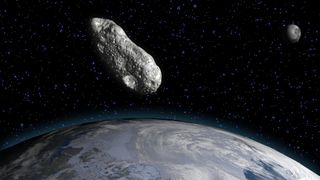
The potentially hazardous asteroid 2024 MK will sail between Earth and the moon on Saturday. (Image credit: JUAN GARTNER via Getty Images)
A skyscraper-size asteroid discovered two weeks ago will zoom between Earth and the moon on Saturday (June 29). At its closest approach, the space rock will pass within roughly 184,000 miles (295,000 kilometers) of our planet — about three-quarters the average distance between Earth and the moon.
The asteroid, named 2024 MK, is estimated to measure about 480 feet (146 meters) across, which is greater than the height of a 40-story building or the Great Pyramid of Giza.
During its closest approach, it will be traveling at roughly 21,000 mph (34,000 km/h), according to NASA. Astronomers in South Africa discovered the asteroid on June 16. READ MORE...
A skyscraper-size asteroid discovered two weeks ago will zoom between Earth and the moon on Saturday (June 29). At its closest approach, the space rock will pass within roughly 184,000 miles (295,000 kilometers) of our planet — about three-quarters the average distance between Earth and the moon.
The asteroid, named 2024 MK, is estimated to measure about 480 feet (146 meters) across, which is greater than the height of a 40-story building or the Great Pyramid of Giza.
During its closest approach, it will be traveling at roughly 21,000 mph (34,000 km/h), according to NASA. Astronomers in South Africa discovered the asteroid on June 16. READ MORE...

